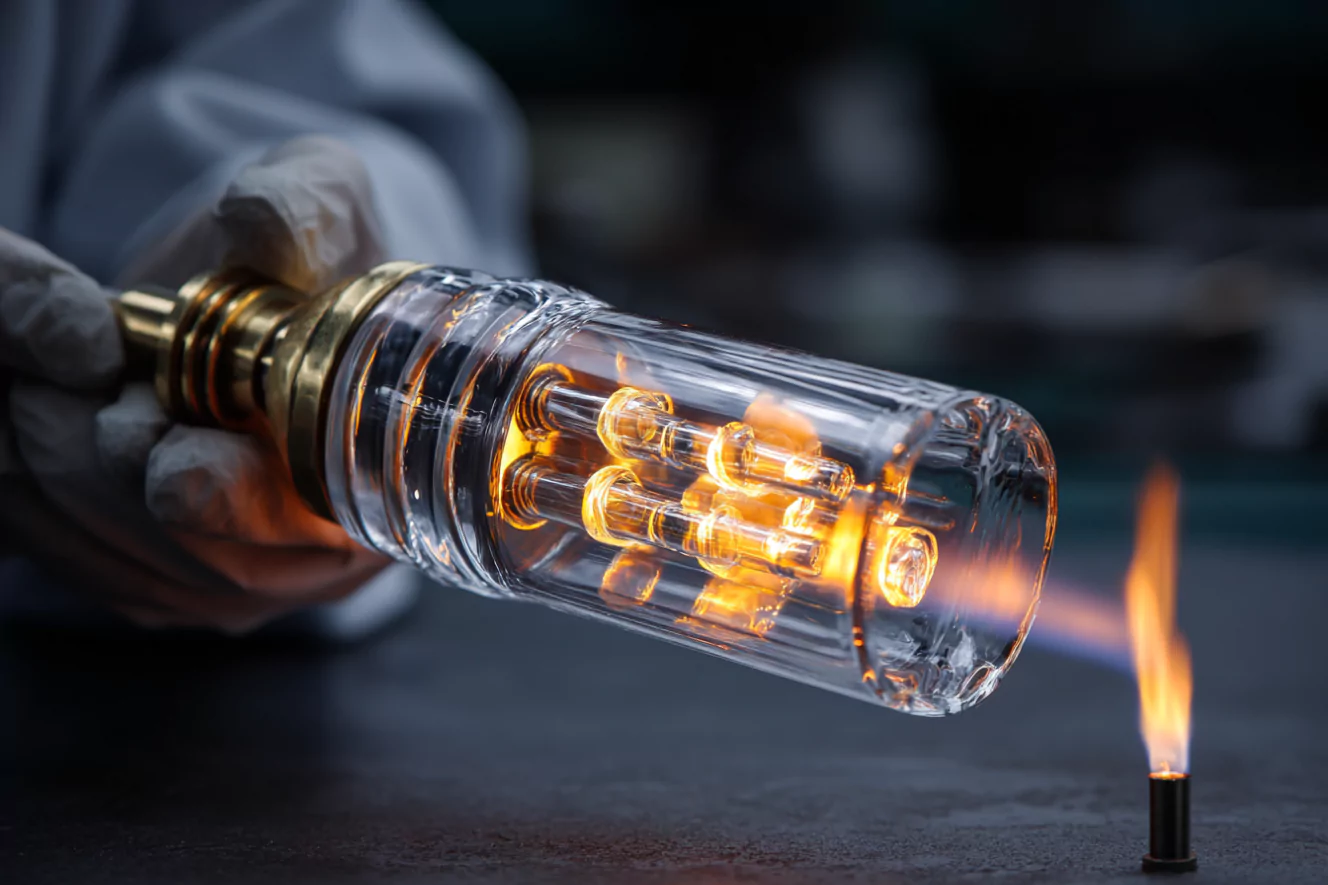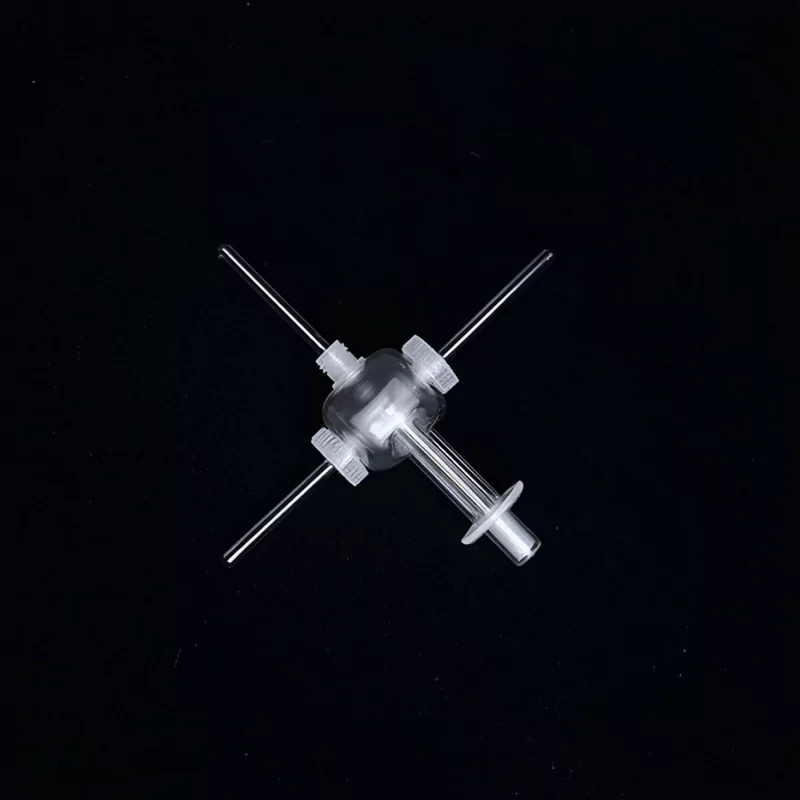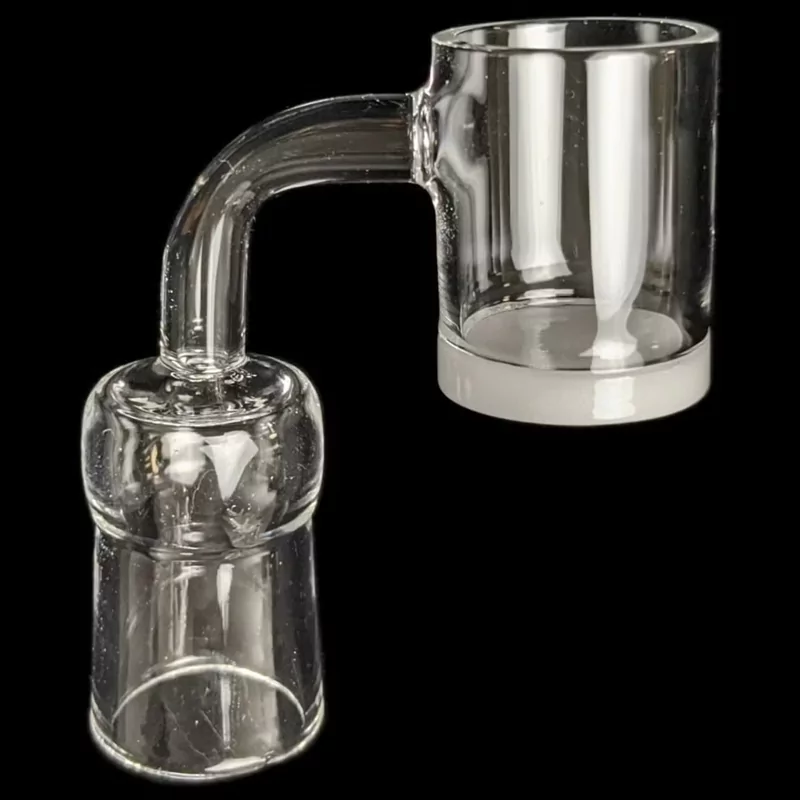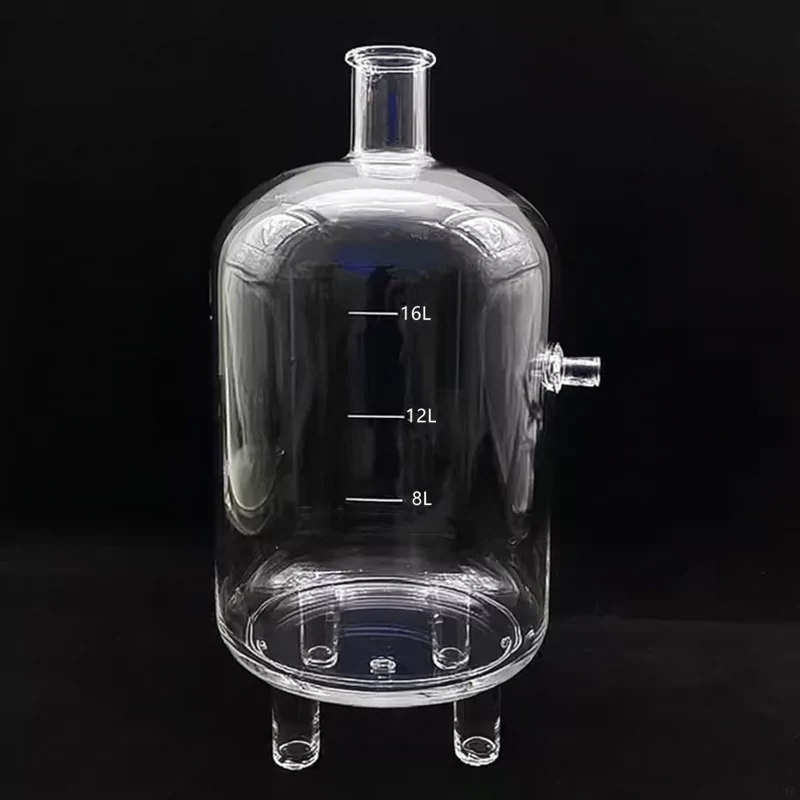- Home
- /
- Types
- /
- Custom Quartz Parts
- /
- Custom Multi-Core Engineered Quartz...
Custom Multi-Core Engineered Quartz Glass Burner for Laboratory & Thermal Systems-TOQUARTZ®
Features of Quartz Glass Burner
TOQUARTZ® quartz glass burners are engineered for demanding high-temperature applications where precision, durability, and material purity are critical. Our burners combine superior material properties with precision manufacturing to deliver reliable performance in laboratory and industrial environments.
Material Purity
Manufactured from 99.99% SiO₂ quartz, ensuring minimal contaminants and consistent performance in sensitive applications.
Temperature Resistance
Withstands operating temperatures up to 1200°C with exceptional thermal stability and low thermal expansion coefficient.
Chemical Resistance
Highly resistant to acids, alkalis, molten salts, and fluorinated gases, maintaining structural integrity in aggressive environments.

-
Core configurations:
3, 7, 9, 12, 15, 19, 21, 30, and 36 cores
-
Customizable
dimensions & specifications
- Temperature resistant Up to 1200°C
Technical Specifications & Dimension of Quartz Glass Burner
TOQUARTZ® quartz glass burners are manufactured to precise specifications to ensure consistent performance in demanding applications. Our standardized models offer various core configurations to meet different flame requirements.
Technical Specifications of Quartz Glass Burner
| Property | Value | Unit | Test Method / Notes |
| Density | 2.2 | g/cm³ | ASTM C693 |
| Tensile Strength | ≥ 350 | MPa | ISO 527 |
| Compressive Strength | ≥ 1100 | MPa | ASTM C773 |
| Young’s Modulus | 72 | GPa | ASTM C623 |
| Poisson’s Ratio | 0.17 | — | Typical for fused quartz |
| Hardness (Mohs) | 5.5 – 6.5 | — | Mohs scale |
| Thermal Conductivity (20°C) | 1.4 | W/m·K | ASTM E1225 |
| Specific Heat (20–100°C) | 670 | J/kg·K | ASTM E1269 |
| Coefficient of Thermal Expansion | 5.5 × 10⁻⁷ | /°C | 20–320°C range, ASTM E831 |
| Maximum Operating Temperature | 1200 | °C | Continuous use |
| Softening Point | 1680 | °C | ASTM C338 |
| Annealing Point | 1215 | °C | ASTM C336 |
| Strain Point | 1120 | °C | ASTM C336 |
| Thermal Shock Resistance | Excellent (ΔT ≥ 250°C) | — | Rapid heating/cooling cycles |
| Electrical Resistivity (20°C) | 7 × 10⁷ | Ω·cm | ASTM D257 |
| Dielectric Strength | 250–400 | kV/cm | ASTM D149 |
| Water Absorption | 0 | % | Non-porous material |
| Transparency (UV–IR range) | 85–92% (depending on wavelength) | % | 200–2500 nm, varies by thickness |
| Surface Finish | Fire-polished or ground (customizable) | — | Based on customer requirement |
| Dimensional Tolerance (Standard) | ±0.1 – ±0.2 | mm | Custom tolerances available upon request |
| Purity (SiO₂ Content) | ≥ 99.99 | % | TOQUARTZ standard grade |
Size Chart of Fused Quartz Glass Burner
| Model | Core Configuration | SiO₂ Purity | Max Temperature | Application |
| AT-SY-PD1001 | 3 Core | 99.99% | 1200°C | Laboratory precision work |
| AT-SY-PD1002 | 7 Core | 99.99% | 1200°C | Small glass processing |
| AT-SY-PD1003 | 9 Core | 99.99% | 1200°C | Medium glass processing |
| AT-SY-PD1004 | 12 Core | 99.99% | 1200°C | Laboratory & glass work |
| AT-SY-PD1005 | 15 Core | 99.99% | 1200°C | Industrial heating systems |
| AT-SY-PD1006 | 19 Core | 99.99% | 1200°C | Large glass processing |
| AT-SY-PD1007 | 21 Core | 99.99% | 1200°C | High-output applications |
| AT-SY-PD1008 | 30 Core | 99.99% | 1200°C | Industrial processing |
| AT-SY-PD1009 | 36 Core | 99.99% | 1200°C | Large-scale industrial processing |
TOQUARTZ® Solving Critical Challenges with Quartz Glass Burners
Quartz Glass Burners in Laboratory Equipment Manufacturing
Key Advantages
-
Stable flame deviation under 0.3°
Maintains flame axis deviation below 0.3° during 8-hour continuous spectroscopy operation. -
Core alignment tolerance within ±0.05mm
Multi-core burner heads maintain internal channel alignment within ±0.05mm for analytical repeatability. -
Contamination index < 0.01 ppm
Manufactured in ISO-classified clean zones, ensuring <0.01 ppm contamination for trace-level analysis.
TOQUARTZ® solution
A German analytical instrument manufacturer reported inconsistent flame profiles during atomic absorption tests, leading to ±7% signal drift. Their previous supplier’s burner heads had core misalignments exceeding ±0.2mm.
TOQUARTZ® delivered 9-core burners with ±0.05mm alignment tolerance and <0.01 ppm contamination index. Post-integration, signal drift was reduced to <1.2%, and calibration frequency dropped by 40%, improving lab throughput.
Fused Quartz Glass Burners for Glass Processing Applications
Key Advantages
-
Thermal uniformity deviation < ±5°C
Delivers consistent flame temperature across 30mm span with deviation under ±5°C during annealing. -
Operational lifespan > 450 hours
Validated in continuous-use environments with >450 hours of stable flame output before replacement. -
Custom nozzle taper angle ±1° precision
Supports nozzle taper customization with ±1° tolerance for directional flame shaping in micro-joining.
TOQUARTZ® solution
A U.S. specialty glassware producer faced 12% defect rates due to uneven annealing caused by burner temperature fluctuations. Their existing burners showed ±15°C variation across the flame zone.
TOQUARTZ® supplied 15-core burners with <±5°C thermal deviation and custom nozzle tapering. Defect rates dropped to 3.5%, and burner replacement cycles extended from 180 to 460 hours.
Quartz Glass Burners in High-Temperature Industrial Systems
Key Advantages
-
Thermal shock resistance ΔT ≥ 280°C
Withstands rapid thermal cycling with ΔT ≥ 280°C without structural cracking or devitrification. -
Mounting flange flatness < 0.1mm
Ensures seamless integration with automated heating systems requiring high-precision mechanical interfaces. -
Gas flow deviation < ±2% across channels
Multi-core burners maintain gas flow deviation under ±2% across all channels for uniform thermal treatment.
TOQUARTZ® solution
A Japanese thermal system integrator required burner heads for a new sintering line operating at 1150°C with 30-second thermal cycles. Their previous supplier’s burners cracked after 120 cycles.
TOQUARTZ® delivered 36-core burners with ΔT ≥ 280°C resistance and flange flatness <0.1mm. The new burners completed over 600 cycles without failure, reducing downtime by 72% and saving approx. ¥1.2 million in maintenance costs per quarter.
TOQUARTZ® Custom Quartz Glass Burner Design & Manufacturing
Custom Core Configurations
Custom core designs from 3 to 36+ cores with specialized patterns for optimized gas mixing and flame characteristics. Ideal for applications requiring specific heat distribution profiles.
Technical Drawing Support
TOQUARTZ® engineering team provides technical drawing support, material recommendations, and design optimization to ensure your quartz glass burner meets application-specific performance requirements.
Specialized Interface Designs
Custom mounting interfaces, connection points, and specialized geometries to integrate seamlessly with your existing equipment or new system designs.
Usage & Maintenance Guidelines of Quartz Glass Burner
Proper handling, installation, and maintenance of quartz glass burners ensures optimal performance and maximum service life. Follow these guidelines to maintain your quartz burner components.
Installation Guidelines
- Ensure all connections are gas-tight using appropriate fittings. Avoid overtightening which can damage the quartz material.
- Use the recommended gas pressures and flow rates specified for your particular burner model to maintain optimal flame characteristics.
- Allow gradual warm-up and cool-down periods of at least 5-10 minutes to minimize thermal shock and extend component life.
Cleaning and Maintenance
- Clean quartz burner nozzles using ultrapure deionized water or laboratory-grade solvents. For stubborn deposits, use dilute (5%) hydrofluoric acid solution with proper safety protocols.
- Inspect regularly for devitrification (whitening of the quartz), which indicates the need for replacement. Typical operating lifespan ranges from 300-500 hours depending on application.
- Store in clean, dry conditions in protective packaging to prevent dust accumulation or physical damage when not in use.
2. Use gas filters upstream of the burner to prevent particulate contamination that can block the fine core channels.
3. For applications requiring precise flame characteristics, consider using digital flow controllers to maintain consistent gas delivery parameters.
Need Quartz Glass Burner Solutions?
Why Partner with TOQUARTZ
Direct Factory Advantage
As a direct manufacturer, we can cut out the numerous intermediate links.
Engineering Expertise
Technical team guides clients from material selection to design optimization, translating specs into deliverables.
Flexible Manufacturing
Handling standard & custom orders via small-batch expertise and prototyping rigor to meet urgent deadlines.
Quality
Assurance
Pre-shipment 3-step validation:
1. dimensional accuracy,
2. material purity ,
3. performance thresholds
Global Supply Chain
Reliable global logistics to industrial hubs (DE/US/JP/KR priority) with trackable milestones.
Releted Products
As a specialized manufacturer with direct factory capabilities, TOQUARTZ provides both standard and custom quartz solutions with engineering support throughout the specification and implementation process.
FAQ
Q: What is a quartz torch used for?
A: Quartz torches are used in laboratory equipment, glass processing, material analysis, and industrial heating applications where a clean, high-temperature flame is required. They provide precise flame control, chemical resistance, and contamination-free operation for applications including spectroscopy, glass joining, and specialized material processing.
Q: Can quartz torches withstand high temperatures?
A: Yes, quartz torches are specifically engineered for high-temperature applications. Our quartz glass burners maintain structural integrity and performance at continuous operating temperatures up to 1200°C. The material’s low coefficient of thermal expansion (5.5 × 10⁻⁷/°C) provides excellent thermal shock resistance, allowing for rapid temperature changes without cracking or deformation.
Q: What core configuration is best for glass processing?
A: For glass processing applications, 7-15 core configurations typically provide the optimal balance of heat distribution and precision. Smaller work (e.g., laboratory glassware) generally benefits from 7-9 cores, while larger industrial glass processing may require 15-21 cores for sufficient heat output. The specific arrangement of cores also affects flame characteristics—concentric patterns provide even heating while asymmetric designs can create directional heating profiles.
Q: How do you clean a quartz torch nozzle?
A: For routine cleaning, rinse quartz torch nozzles with ultrapure deionized water followed by a laboratory-grade solvent like acetone or methanol. For stubborn deposits, a dilute (5%) hydrofluoric acid solution can be used with proper safety protocols. Alternatively, a hydrogen peroxide/ammonia solution (1:1:5 ratio of 30% H₂O₂, NH₄OH, H₂O) effectively removes organic contaminants. Always rinse thoroughly with deionized water and dry with filtered compressed air or nitrogen.
Q: Can quartz glass burners be customized?
A: Yes, TOQUARTZ specializes in custom quartz glass burner solutions. We can customize core configurations (3-36+ cores), dimensions, interface connections, and special geometries according to your technical drawings or requirements. Our engineering team provides design support to optimize performance for specific applications, with prototype development typically completed within 2-3 weeks.
Contact our engineering team for technical consultation and pricing. We’ll help you select the optimal specifications for your application requirements.








